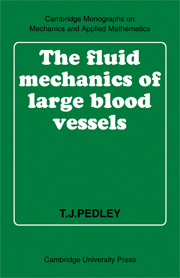Book contents
- Frontmatter
- Contents
- Preface
- 1 Physiological introduction
- 2 Propagation of the pressure pulse
- 3 Flow patterns and wall shear stress in arteries
- 4 Flow patterns and wall shear stress in arteries
- 5 Flow patterns and wall shear stress in arteries
- 6 Flow in collapsible tubes
- Appendix: Analysis of a hot-film anemometer
- References
- Index
2 - Propagation of the pressure pulse
Published online by Cambridge University Press: 05 March 2012
- Frontmatter
- Contents
- Preface
- 1 Physiological introduction
- 2 Propagation of the pressure pulse
- 3 Flow patterns and wall shear stress in arteries
- 4 Flow patterns and wall shear stress in arteries
- 5 Flow patterns and wall shear stress in arteries
- 6 Flow in collapsible tubes
- Appendix: Analysis of a hot-film anemometer
- References
- Index
Summary
It is the propagation of the pulse that determines the pressure gradient during the flow at every location in the arterial tree, so it is important to begin the mathematical analysis of arterial fluid mechanics with a description of this propagation. The most concise and easily comprehensible outline of the subject is that by Lighthill (1975, chapter 12), and I shall frequently refer to his account in what follows.
One-dimensional theory, uniform tube, inviscid fluid
Basic theory
It is necessary, as in most branches of applied mathematics, to analyse a simple model before introducing the many modifying features present in reality. We therefore start by considering the propagation of pressure waves in a straight, uniform, elastic tube, whose undisturbed cross-sectional area and elastic properties are independent of the longitudinal coordinate, x. We also take the blood to be inviscid, as well as being homogeneous and incompressible (density ρ); the last two assumptions are made throughout this book. The neglect of viscosity is based on the observation (§§ 1.2, 1.3) that the velocity profiles in large arteries are approximately flat, suggesting that the effect of viscosity is confined to thin boundary layers on the walls; this is confirmed mathematically below. We further suppose that the wavelengths of all disturbances of interest are long compared with the tube diameter, so that the velocity profile will remain flat at all times, and the motion of the blood can be represented by the longitudinal velocity component u(x, t), where t is the time.
- Type
- Chapter
- Information
- The Fluid Mechanics of Large Blood Vessels , pp. 72 - 125Publisher: Cambridge University PressPrint publication year: 1980
- 2
- Cited by



